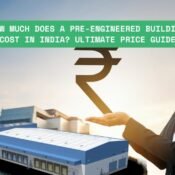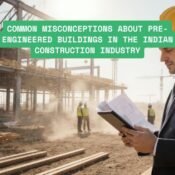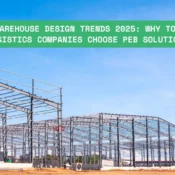
The Environmental Advantages of Prefabricated Steel Buildings
Introduction: A Shift Born from Struggle
In 2020, as India grappled with a surge in industrial development post-lockdown, many business owners faced a harsh reality. Construction delays, rising material costs, and increasing environmental regulations created the perfect storm. Industries—from logistics hubs in Gujarat to agro-processing units in Madhya Pradesh—struggled to expand efficiently without compromising sustainability mandates.
For many, traditional construction methods became a bottleneck. They were slow, expensive, and environmentally taxing. That's when a growing number of business owners turned to an alternative that’s been reshaping global infrastructure: prefabricated steel buildings.These PEB (Pre-Engineered Building) solutions offered more than speed—they came with significant environmental benefits, opening new doors for sustainable construction in India. In this blog, we’ll explore how eco-friendly PEBs are revolutionizing the Indian construction sector and why companies like Metal Tree are at the forefront of this green building transformation.
Table of Contents
- Why Prefabricated Steel Buildings Are Gaining Traction in India
- Understanding the Environmental Benefits of PEB
- Green Building Solutions: The PEB Edge
- Steel Construction Sustainability: A Lifespan Advantage
- Case in Point: How PEBs Empower India's Eco-Conscious Builders
- Conclusion: Building a Greener India with Steel
- FAQs
Why Prefabricated Steel Buildings Are Gaining Traction in India
India's construction industry is the third-largest globally, but it's also one of the most resource-intensive. Traditional construction methods consume massive amounts of water, cement, and time. That’s where prefabricated steel buildings step in.
These structures, manufactured off-site and assembled on-site, are rapidly transforming urban and industrial infrastructure. Why?
Because they tick all the boxes:
- Faster construction timelines
- Cost savings
- Scalability
- Most importantly, reduced environmental impact
The environmental benefits of PEB aren't just a bonus; they’re becoming a necessity as industries face pressure to lower carbon footprints and adhere to green compliance regulations.

Understanding the Environmental Benefits of PEB
1. Reduced Construction Waste
Conventional building projects are notorious for waste—excess bricks, mortar, broken tiles, and surplus concrete. In contrast, PEBs are designed, cut, and pre-engineered with precision, leaving minimal room for waste.
Off-site manufacturing ensures that materials are reused, recycled, and optimized before they even reach the site.
2. Lower Carbon Emissions
By reducing the need for heavy machinery and wet construction processes, prefabricated steel buildings significantly cut down on-site emissions. Steel itself, being recyclable, adds to the sustainability factor.
3. Less Resource Consumption
Steel construction uses less water compared to traditional methods. With India facing severe water stress in many regions, this alone makes PEBs a valuable alternative.
Green Building Solutions: The PEB Edge
When we talk about green building solutions, it's not just about installing solar panels or rainwater harvesting systems. It starts with the structure itself.
Eco-friendly PEB structures contribute to green ratings like GRIHA and IGBC due to their energy-efficient insulation, reduced embodied energy, and recyclability.
Energy Efficiency from the Ground Up
PEBs can be designed with thermal insulation panels and reflective roofing materials that reduce HVAC loads by up to 30%, directly impacting operational energy consumption.
Modular and Adaptive Design
As industries evolve, facilities need to expand. PEBs are modular, making expansion or repurposing much easier and more sustainable than demolishing and rebuilding.

Steel Construction Sustainability: A Lifespan Advantage
Steel is among the most durable and recyclable materials on Earth. Its lifecycle aligns perfectly with long-term sustainable construction in India.
Recyclability Without Degradation
Unlike wood or concrete, steel can be recycled repeatedly without losing strength or quality. This ensures that even after a building’s functional life, its materials continue to contribute to other projects.
Durability Reduces Maintenance
A well-constructed PEB can withstand seismic activities, corrosion (with appropriate coating), and extreme weather. Less maintenance means fewer resources consumed over time—again supporting the environmental benefits of PEB.
Case in Point: How PEBs Empower India's Eco-Conscious Builders
Several sectors across India—from e-commerce warehousing to educational institutions—have embraced prefabricated steel buildings. Why? Because they are future-ready, resilient, and clean.
For example, a logistics park in western India, struggling with delays due to monsoon, switched to PEB and completed its infrastructure 40% faster than planned. The shift not only saved time but reduced diesel usage from generators and construction vehicles by over 60%.
The environmental benefits of PEB weren’t just theoretical—they were measurable, impacting compliance reports and operational budgets alike.
"The industrial world no longer needs to choose between growth and green. Prefabricated steel buildings allow us to construct facilities that are not only efficient and cost-effective but also aligned with environmental responsibility. In every beam and panel lies a step toward smarter, cleaner infrastructure that meets the demands of today without sacrificing tomorrow."

CConclusion: Building a Greener India with Steel
The rise of prefabricated steel buildings in India signals more than just an industry trend—it’s a response to a growing demand for sustainable construction in India.
Companies are no longer choosing between growth and green—they’re finding ways to achieve both, thanks to eco-friendly PEB solutions.
As a pioneer in this space, Metal Tree is committed to pushing the boundaries of sustainable construction, one steel beam at a time. From reducing waste to enabling rapid deployment with minimal environmental disruption, the advantages are clear.
The future of India’s infrastructure is green. And steel is the backbone.
Are you ready to discuss your next project ? Contact Us
Frequently Asked Questions
1. What are the main environmental benefits of PEB?
PEBs reduce construction waste, lower emissions, and consume fewer natural resources compared to traditional buildings.
2. How long does it take to build a prefabricated steel building?
Typically, PEBs can be constructed 30–60% faster than conventional buildings, depending on size and location.
3. Are prefabricated steel buildings sustainable long-term?
Yes. Steel is recyclable, durable, and requires minimal maintenance, making PEBs a sustainable long-term choice.
4. Can PEBs help reduce operational energy costs?
Absolutely. With insulation and energy-efficient materials, PEBs can significantly cut down HVAC and lighting costs.
5. Are there government incentives for eco-friendly buildings in India?
Yes. Green-certified buildings can benefit from faster approvals and in some cases, property tax rebates depending on the state policies.
Green Rating for Integrated Habitat Assessment (GRIHA)
Follow us on:
One thought on “The Environmental Advantages of Prefabricated Steel Buildings”
Add a Comment Cancel reply
All Categories
Recent Posts
How Much Does a Pre-Engineered Building Cost in India? Ultimate Price Guide
Tags
Call Us at
+91 9311624628





[…] Environmental regulations demand greener solutions. […]